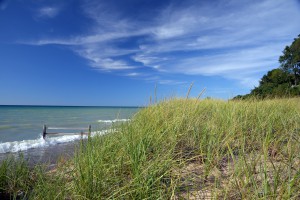Conflicting Views on Shoreline Management
There’s no argument that the cumulative effect of all of the engineered coastlines along the North Shore of Chicago has had a significant repercussions. The act of removing shoreline stabilizing plants, trucking in sand, and eliminating or disturbing shorebird nesting areas has had a devastating effect on Lake Michigan’s habitat and ecosystem. Yet lakeshore property left alone is also at risk for significant ecological damage because of the erosional nature of Lake Michigan’s western coastline.
Elevated properties containing bluffs and ravines along the Great Lakes shoreline, such as those we see on Lake Michigan’s North Shore, are particularly prone to erratic and devastating erosion. It’s not unheard of for homeowners to experience catastrophic bluff erosion overnight or have their entire beach disappear after a severe storm. Proper beach development, planning, and maintenance can provide enormous insurance against these types of devastating losses.
 The good news is that today’s innovate methods of coastline restoration have minimal negative environmental impacts. Coastal engineers are now capable of building beaches that provide habitat for native plants and animals, serve as beautiful recreation areas for area residents and homeowners, and only minimally effect downdrift shorelines.
The good news is that today’s innovate methods of coastline restoration have minimal negative environmental impacts. Coastal engineers are now capable of building beaches that provide habitat for native plants and animals, serve as beautiful recreation areas for area residents and homeowners, and only minimally effect downdrift shorelines.
Waves pose the biggest threat to lakefront property, while varying water levels, surface runoff, and groundwater all take their toll on bluffs, ravines, and beaches. Many homeowners choose to hire companies to manage their shorelines in order to mitigate these threats. While there is never a foolproof way to prevent damage from Mother Nature, a combination of simple solutions can have long-term effects on shoreline stability. Creating revetments, redirecting groundwater, and increasing native plantings are a few easy ways to preserve the shoreline. When done correctly, beach cleaning and grooming also play a vital role in sustainable beach management, improving both the aesthetics and biodiversity of the shoreline.
At The Beach Comber, we understand and pay careful attention to the ongoing debate regarding the pros and cons of beach grooming. While beach grooming can decrease biodiversity in natural beaches, the Beach Comber primarily cleans engineered beaches and therefore does not disrupt natural habitat.
Beach cleaning and grooming is a deceptively complex endeavor, especially here on Lake Michigan, because the lake’s beaches are not easily accessible by land. Unfortunately, many beach cleaning services don’t have the training or knowledge to properly manage and groom lakeside property. Mechanized raking and grooming, if not done properly, can have long-range negative effects on the sustainability of your shoreline. Ripping out shore-stabilizing plants and raking with equipment designed for the finer-grained sand of south Florida beaches destroys sand-binding vegetation and disrupts the delicate stability of your beach. Improper beach grooming results in over-aerated sand more vulnerable to wind erosion and produces a sterile environment by removing valuable organic debris in the strand (or wrack line). Habitat, nesting and feeding grounds for a variety of shoreline birds, invertebrates, insects, and vegetation is lost. The resulting “pristine” beach may be enjoyable in the short-term, but ultimately results in a lifeless beach lacking in biodiversity and more susceptible than ever to erosion.
Most shoreline experts agree that seasonal, zonal, and rotational grooming all contribute to a healthy lakeside ecosystem and provide a safer, more inviting beach. Smaller, privately owned beaches particularly benefit from seasonal grooming. First of all, grooming rids the beach of plastics, fishing line, and other refuse harmful to wildlife. Secondly, raking aerates the sand and creates more surface area for sunlight to reach. This is important because sunlight destroys harmful bacteria in the sand, including E. coli and staphylococus. Grooming also reduces the number of nuisance insects and rids your beach of excess seaweeds that produce unpleasant smells. In addition, the Beach Comber often plants native dune grass, a practice that further stabilizes the shore.
Beach management is a relatively new, evolving science. In the past decade, beach managers, regulators, and scientists have spent significant funds and time working together toward conservation and sharing beaches with wildlife. Those who still consider grooming invasive must take into consideration the many benefits of beach grooming and that any minor disruption to plant and animal life is offset by leaving the beach more or less alone and allowing wrack lines to build during the off season.
Our focus at The Beach Comber is to provide private lakefront property owners with seasonal beach cleaning and grooming services that create clean, inviting, ecologically sound beaches. Unlike other services, we arrive and depart lakeside in order to limit the disruption of natural habitat. Our customized, top-of-the-line equipment rids your sand of unsightly trash, large rocks, and harmful bacteria — but maintains sediment and smaller pebbles that help preserve shoreline integrity and prevent erosion. When raking your beach, we pay careful attention not to disturb seedlings and vegetation colonies in upper beach and foredune areas. We also steer clear of native plantings and possible nesting areas in order to protect essential habitat for natural wildlife. The result? A naturally beautiful beach with a perfect balance of sand, silt, and swash zone. A place to relax, kick back, and dig your toes into the sand. You’ll be amazed at the look and feel of your freshly groomed beach and wonder how you ever survived without us. Interested in learning more? Discover the benefits of our Stay Beautiful Program today.
